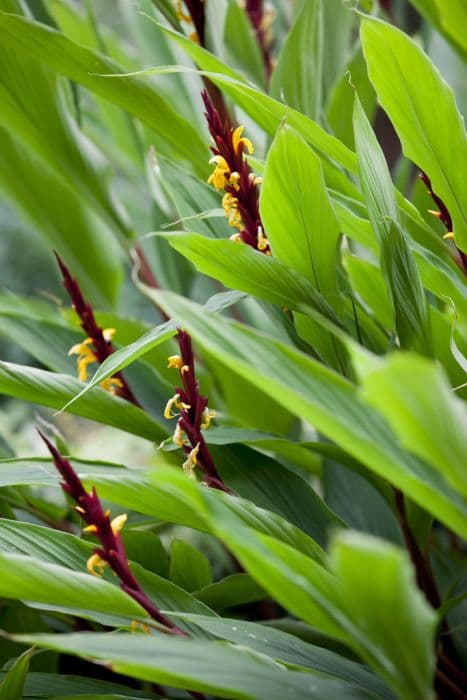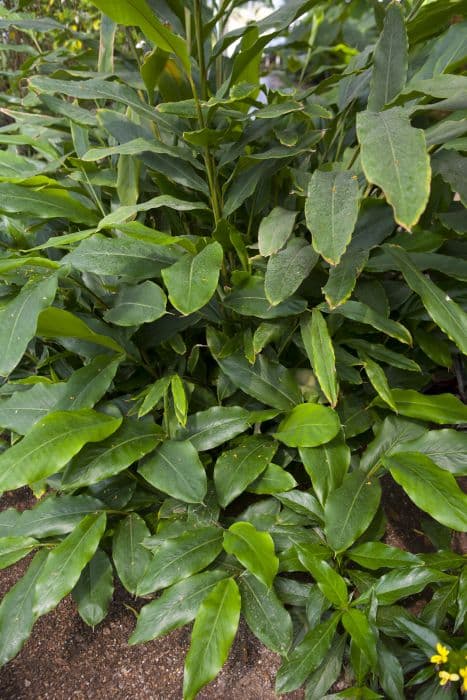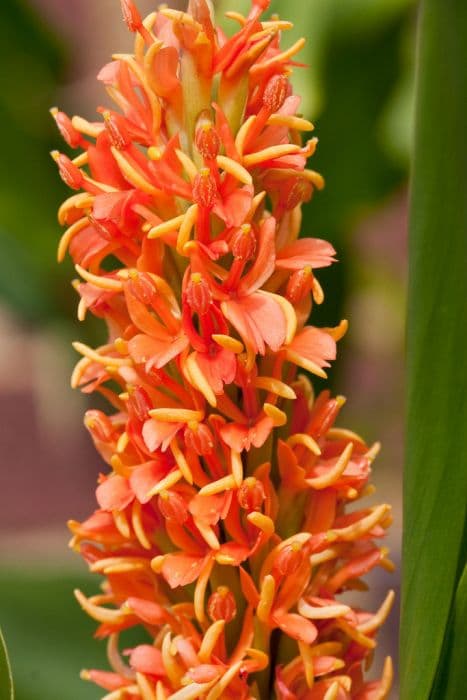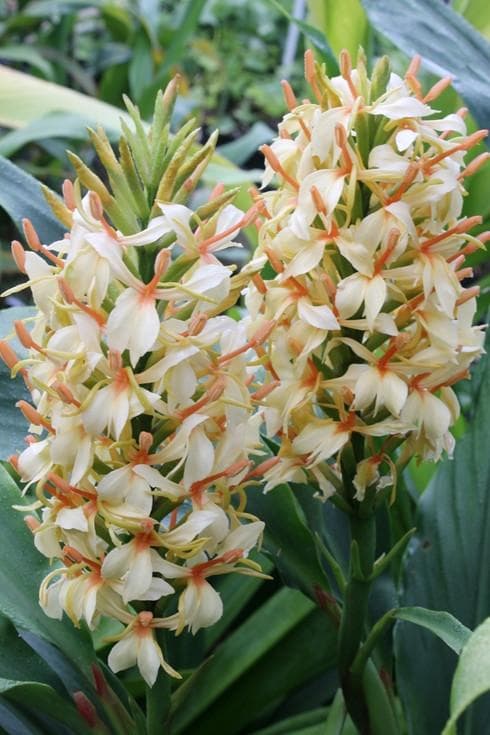Hardy Ginger Lily Cautleya spicata

ABOUT
Cautleya spicata, commonly known as Hardy Ginger Lily, is a visually striking plant. It has a lush, green foliage that comprises lance-shaped leaves which are elongated with a smooth and glossy texture, giving the plant a tropical appearance. The leaves grow in an upright fashion, emerging from a central stem and create a dense clump, presenting a full and bushy aspect. The Hardy Ginger Lily is particularly admired for its inflorescences or flower clusters. These blossoms emerge on terminal spikes and are typically a vibrant shade of yellow or light orange, often with delicate red or brassy accents. The individual flowers are intriguing, with a tubular structure that flares at the mouth into several segments, giving them an ornate look. These attractive blooms are encased in colorful bracts that can be as attractive as the flowers themselves. Adding to the plant's appeal are the seed capsules that form after flowering. These spherical or ellipsoid capsules add an extra dimension of interest to the plant's appearance, maturing to a hue that compliments the foliage. The Hardy Ginger Lily's unique tropical aesthetic is not just an ornamental delight but is also complemented by a subtle, pleasing scent that makes it a favorite among garden enthusiasts. This scent is typically more pronounced in the warmth of the afternoon, inviting not just human admirers but also pollinators such as bees and butterflies to the garden.
About this plant
 Names
NamesSynonyms
Spiked Cautleya, Hardy Ginger Lily, Himalayan Ginger, Ginger Lily.
Common names
Roscoea purpurea var. spicata, Cautleia spicata
 Toxicity
ToxicityTo humans
Cautleya spicata, commonly known as Hardy Ginger Lily, is not widely reported to be toxic to humans. However, it is always prudent to avoid ingesting parts of ornamental plants due to potential unknown toxins. Ingesting any part of an ornamental plant like the Hardy Ginger Lily may cause gastrointestinal discomfort or more serious symptoms in individuals with sensitivity or allergies to certain plant compounds.
To pets
There is limited information on the toxicity of Hardy Ginger Lily (Cautleya spicata) to pets. As with many ornamental plants, it is generally advisable to prevent pets from ingesting the plant. If a pet ingests Hardy Ginger Lily, they may experience mild to moderate gastrointestinal upset, which could include symptoms like vomiting or diarrhea. Pets with a particular sensitivity or allergy to the plant may have more serious reactions. If you suspect your pet has ingested this plant, consider contacting a veterinarian.
 Characteristics
CharacteristicsLife cycle
Perennials
Foliage type
Deciduous
Color of leaves
Green
Flower color
Yellow
Height
2 feet (60 cm)
Spread
2 feet (60 cm)
Plant type
Herb
Hardiness zones
7
Native area
Himalayas
Benefits
 General Benefits
General Benefits- Ornamental value: Cautleya spicata, also known as Hardy Ginger Lily, has a striking appearance due to its exotic-looking flowers making it a popular choice for ornamental gardening.
- Attracts Pollinators: The flowers of the Hardy Ginger Lily can attract bees and butterflies, enhancing pollination in the garden.
- Shade tolerance: This plant is suitable for shaded areas in the garden, where other plants might not thrive as well.
- Low maintenance: Hardy Ginger Lily generally requires minimal care once established, making it ideal for gardeners seeking low-maintenance plants.
- Drought-resistance: Once established, Cautleya spicata can withstand periods of drought, which is beneficial in drier climates or for water conservation efforts.
 Medical Properties
Medical PropertiesThis plant is not used for medical purposes.
 Air-purifying Qualities
Air-purifying QualitiesThis plant is not specifically known for air purifying qualities.
 Other Uses
Other Uses- Flower Arrangement - The vibrant flowers of the Spiked Ginger Lily make it an exotic addition to floral displays and bouquets, adding a touch of the tropics to the arrangement.
- Ornamental Gardening - As an ornamental plant, Spiked Ginger Lily is used to add color and structure to garden borders, particularly in semi-shaded areas.
- Conservatory Plant - In colder climates, the Spiked Ginger Lily is often grown in conservatories where the warmth and controlled environment allow it to thrive.
- Natural Clothing Dye - The brightly colored flowers may potentially be used to produce a natural dye for textiles, imparting hues of yellow or orange.
- Perfumery - The fragrant flowers could be explored for their essential oils to be used in making perfumes or fragrant sachets.
- Biological Studies - Used in botanical research to study the growth habits and pollination mechanisms of ginger family plants.
- Photography Subject - Its striking appearance makes the Spiked Ginger Lily a popular subject for botanical photographers and plant enthusiasts.
- Shade Garden Accent - As a shade-tolerant plant, it can be used to provide color and interest in shaded garden spots where other flowering plants might struggle.
- Cultural Significance - In different cultures, the Spiked Ginger Lily may be featured in traditional celebrations or ceremonies, honored for its beauty and rarity.
- Erosion Control - When planted on slopes or areas prone to erosion, the root systems of Spiked Ginger Lily can help to retain soil and prevent erosion.
Interesting Facts
 Feng Shui
Feng ShuiThe Cautleya spicata, commonly known as Hardy Ginger Lily, is not used in Feng Shui practice.
 Zodiac Sign Compitability
Zodiac Sign CompitabilityThe Hardy Ginger Lily is not used in astrology practice.
 Plant Symbolism
Plant Symbolism- Tropical Exoticism: As Cautleya spicata, commonly known as the Hardy Ginger Lily, originates from high-altitude regions in the Himalayas, its lush, tropical appearance symbolizes exotic beauty and the allure of the unknown.
- Adaptation: Hardy in cooler climates despite its tropical origin, the Hardy Ginger Lily symbolizes the ability to adapt and thrive in various environments, reflecting resilience and versatility.
- Radiance: The vibrant, colorful blooms of the Hardy Ginger Lily are often seen as a symbol of brightness and positivity, bringing light and cheer to any setting.
- Rejuvenation: As the plant dies back in winter and re-emerges in the spring, it represents renewal and rebirth, reminding us of the cycles of nature and the promise of new beginnings.
 Water
WaterThe Spiked Ginger Lily requires watering that keeps the soil consistently moist but not waterlogged. During the growing season in spring and summer, water the plant thoroughly once the top inch of soil feels dry to the touch, which usually amounts to approximately once a week. Use roughly 16-24 ounces of water for smaller pots, or up to 1-2 gallons for larger outdoor plants, depending on size. Reduce the amount of water in the fall and winter when the plant is not actively growing. Always ensure that the pot has drainage holes to prevent excess water from accumulating and causing root rot.
 Light
LightThe Spiked Ginger Lily flourishes best in bright, indirect light. Choose a spot that receives dappled sunlight or partial shade, especially in areas with hot afternoon sun, to prevent scorching the leaves. An east or west-facing window or a position under the canopy of taller trees would be ideal to provide the light needed without direct, harsh exposure.
 Temperature
TemperatureThe Spiked Ginger Lily thrives in temperatures between 55 and 75 degrees Fahrenheit. It can tolerate a minimum temperature of 40 degrees Fahrenheit and a maximum of around 80 degrees Fahrenheit, but prolonged exposure outside this range may stress the plant. The ideal temperature for promoting growth and flowering is within the middle of this range, favoring the warmer end.
 Pruning
PruningPruning the Spiked Ginger Lily is essential to encourage bushier growth and more blooms. Trim back leggy stems and spent flowers after the blooming period to promote new growth. The best time to prune is in late winter or early spring before new growth begins. Avoid excessive cutting, focusing mostly on shaping the plant and removing any dead or damaged tissue.
 Cleaning
CleaningAs needed
 Soil
SoilThe Spiked Ginger Lily (Cautleya spicata) thrives in a well-draining, fertile soil mix with high organic content. A mixture of two parts peat, one part perlite, and one part compost would be ideal. The soil pH should be slightly acidic to neutral, ranging from 6.0 to 7.0 for optimal growth.
 Repotting
RepottingSpiked Ginger Lilies should be repotted every 2-3 years to prevent overcrowding and renew the soil. Best done in spring, choose a pot only slightly larger than the previous as they prefer to be somewhat root-bound.
 Humidity & Misting
Humidity & MistingSpiked Ginger Lily enjoys high humidity levels, ideally around 60-70%. Strive to maintain this by using humidity trays or misting regularly, especially when grown indoors.
 Suitable locations
Suitable locationsIndoor
Provide bright, indirect light and keep the Spiked Ginger Lily in warm temperatures.
Outdoor
Plant in partial shade, sheltered from wind, in moist soil.
Hardiness zone
7-10 USDA
 Life cycle
Life cycleCautleya spicata, commonly known as Hardy Ginger, begins its life cycle with seed germination, typically requiring a warm and moist environment. After germination, the seedling develops into a vegetative state, where it grows leaves and stems, although this plant may also propagate asexually through rhizome division. Over time, the Hardy Ginger reaches maturity and produces characteristic bracts and flowers during the warm months, attracting pollinators for sexual reproduction. Once pollinated, the flowers develop into seed pods, which eventually dry and release seeds, continuing the cycle. In colder climates, Cautleya spicata dies back to its rhizomes in the winter, undergoing a period of dormancy, and re-sprouts in spring. This perennial cycle repeats annually, with the plant increasing in size and vigor through the years.
 Propogation
PropogationPropogation time
Late spring-summer
The most popular method of propagation for Cautleya spicata, commonly known as Hardy Ginger Lily, is by division of the rhizomes. This is often done in the spring as the plants are emerging from dormancy. Carefully dig up the clump of the plant, and then using a sharp knife, divide the rhizome into sections, each with at least one growth bud. Afterward, the divisions should be planted in pots with well-draining soil at a depth of approximately 2 inches (about 5 cm) before being watered in. These pots can be kept in a warm, shaded area until the new growth is established and can then be transplanted to their final location in the garden.









